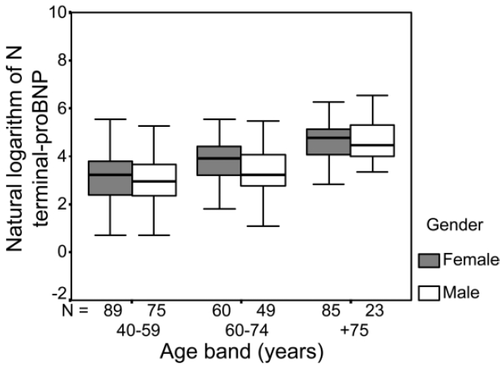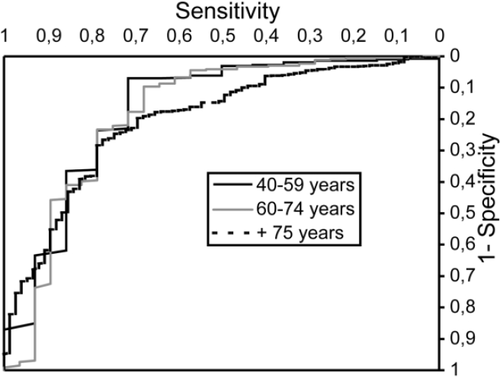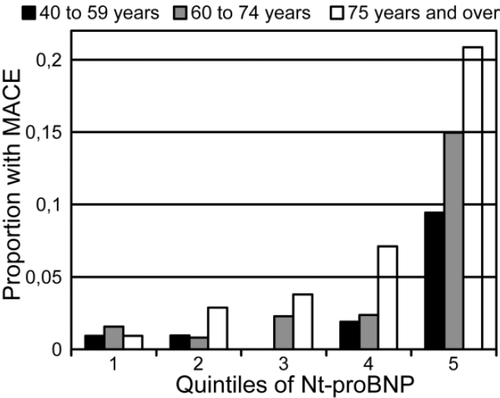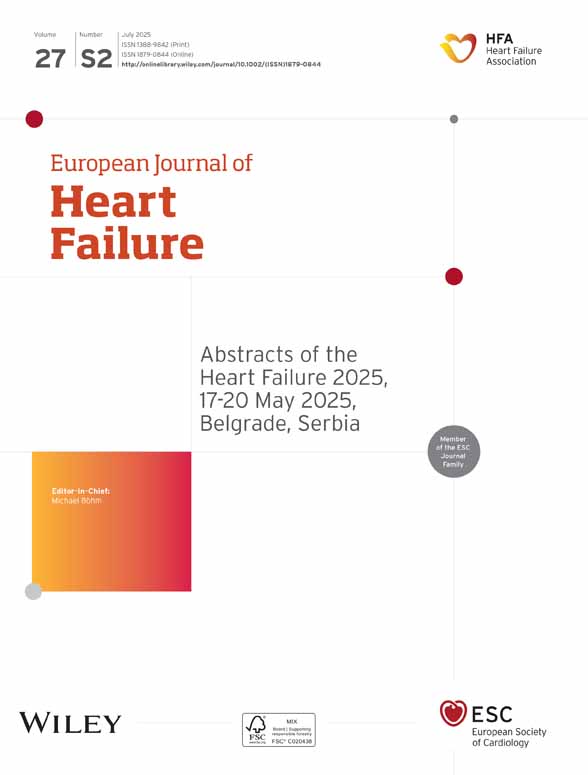Value of N-terminal pro brain natriuretic peptide in the elderly: data from the prospective Copenhagen Hospital Heart Failure study (CHHF)
Abstract
We describe the value of Nt-proBNP in relation to cardiac normality and risk of major adverse cardiac events (MACE) in consecutive hospitalised patients below and above 75 years of age. Method: During a 10 month period 2224 consecutive patients, admitted to all departments in a general city hospital, had a full cardiac examination and were prospectively followed for 1 year. We identified a normal group (without obvious heart disease) and a group with MACE (significant heart disease at admission or a cardiac event within the following 90 days). NT-proBNP measurements were done using an ELISA—a two-step sandwich assay with streptavidin coated microtitre plates. Results: The age dependent 90th percentiles of Nt-proBNP in the normal group were approximately 3 times higher than values reported in previous community studies. Elderly patients had 3-fold higher absolute cut off values than did patients under the age of 75 years. One-hundred-and-sixteen patients had a MACE, and areas under the receiver operating curve (ROC) to predict a MACE were 0.83 (from 40 to 59 years), 0.82 (60 to 74) and 0.79 (from 75 years). In younger patients, the upper limit of Nt-proBNP in normal patients was similar to the value, which defined the top quintile of risk. In patients aged greater than 75 years the predictive cut point included more than 40% of the population.
Conclusion:
Nt-proBNP was useful at all ages but specificity was slightly lower in the elderly. Cut off values in hospitalised cardiac normal patients are approximately three times higher than community derived values.
1. Introduction
Cardiac natriuretic peptides are independent markers of heart failure and mortality in a variety of populations 1,2. Although reference values have been derived for Nt-proBNP 3 and BNP, few elderly subjects were included in these studies and community derived reference values might not apply to hospitalised patients. Plasma concentrations of BNP and Nt-proBNP are strongly affected by age 4 and medical treatment 5. In addition, a large proportion of elderly patients are being treated for hypertension, which may change the plasma levels of NT-proBNP in an unpredictable way.
In two small studies of octogenarians, BNP was strongly correlated to mortality 6 and heart failure 7. However, there is a lack of studies examining plasma levels of Nt-proBNP in elderly hospitalised patients and it is not clear if N-terminal proBNP is as useful in the elderly as it is in younger patients.
The aim of the present analysis was to derive reference values for Nt-proBNP in an elderly hospitalised population and secondly to examine the value of Nt-proBNP to predict major cardiac adverse events in subjects aged below and above 75 years.
2. Method
2.1. Patients and study design
We performed a retrospective analysis based on the Copenhagen Hospital Heart Failure study (CHHF) that examined all patients above the age of 40 years admitted to the general city hospital Amager Hospital Copenhagen, between 1 April 1998 and 31 March 1999. A detailed description of the study has been previously published 8,9. During this period 89% of consecutively admitted patients agreed to participate in the study and gave written informed consent. The present analysis included 2224 patients, from whom blood samples were drawn for the analysis of NT-proBNP during the last 10 months of the study. The regional ethics committee of the city of Copenhagen formally approved the study.
2.2. Investigations
Within 24 h of admission all patients underwent a structured comprehensive clinical examination including heart and lung auscultation. The medical history was obtained (by MB and VK) without knowledge of the results of LVEF and NT-proBNP. After discharge, the hospital records were evaluated and the final diagnosis (International classification of diseases 10), routine laboratory results, and drug treatment at time of discharge were recorded. A 1-year follow-up was performed, which recorded vital status, development of heart disease and cause of death from death certificates.
2.3. Cardiac normal population
A population without obvious heart disease was defined by the following criteria: sinus rhythm, LV ejection fraction >0.55 and no valvular heart disease or dilated or congenital heart disease at referral. Exclusion criteria were blood pressure >165/100, serum creatinine >130 mmol/l, symptoms suggestive of heart failure, and treatment with a diuretic, beta-blocker or an ACE-inhibitor. Further important exclusion criteria were death, heart failure, myocardial infarction or valvular disease diagnosed within the following year.
2.4. Major adverse cardiac events
Major adverse cardiac events (MACE) were defined as LV ejection fraction <0.35, valvular heart disease, pulmonary congestion on the chest—X-ray at the time of admission or development of one of the following incidents during a 90 day follow up period: symptoms of heart failure, myocardial infarction, valvular disease, sudden death or cardiac death.
2.5. Echocardiogram
Echocardiography was done within 24 h of admission (by MB or VK) 8. LVEF was estimated according to Teichholz and colleagues in all subjects with a homogeneous contraction pattern. 11 If there was a heterogeneous contraction pattern, LVEF was estimated from the wall motion index. 12 Inter-observer variations in the evaluation of LVEF was 4% (r=0.95; n=12).
2.6. Analysis of NT-proBNP
Blood samples were drawn between 8.00 am and 10.00 am within 24 h of admission. Samples were collected in pre-chilled tubes containing EDTA, immediately placed on ice, and promptly centrifuged at 4 °C. After separation, plasma was stored at −80 °C. NT-proBNP measurements were done using an ELISA—a two-step sandwich assay with streptavidin coated microtitre plates. 8,13. This assay does not require sample extraction and there is no detectable cross reactivity with ANP, NT-proANP, BNP, or urodilatin. The inter-assay and intra-assay variances were 10% and 3%, and recovery was between 104% and 112%. The present study used an earlier generation assay (ELISA method), and the conversion factor from the present assay to the Roche Elecsys pro-BNP assay is NT-proBNP (Elisa, pmol/l)=NT-proBNP (Elecsys, pmol/l) *2.7, (information from Roche diagnostics (C)). To convert pmol/l to pg/ml, multiply pmol/l by 8.475.
2.7. Statistical analysis
NT-proBNP values were transformed by the natural logarithm. Means of variables were compared by Students t-test. All comparisons were performed at each age band: 40–59 years of age, 60–74 years of age, and older than or equal to 75 years of age. Data for men and women were combined because of few men at each age band and because mean values in normal patients were not statistically different between men and women.
Receiver operating curve (ROC) illustrated the value of Nt-proBNP to predict a MACE at each age band. The proportion of patients with a MACE was illustrated in relation to quintiles of Nt-proBNP at each age band.
3. Results
3.1. Normal values
A total of 2224 consecutively admitted patients had blood samples drawn during the prospective study period of 10 months. Cardiac normal individuals were identified at each age band: 164 patients at 40–59 years, 109 patients at 60–74 years and 108>75 years of age. Patients had normal mean serum creatinine at 70 μmol/l (68, 71, and 71 μmol/l at each age band), blood pressure 136/79 mmHg (133/81, 137/79, 140/78 mmHg) and heart rate 85 per min (86, 85, 82 per min). Upon discharge 2% received a diuretic, 3% a beta-blocker, and 0.5% an ACE-inhibitor.
Fig. 1 shows the natural logarithm of Nt-proBNP in relation to sex and age. Mean plasma Nt-proBNP increased with age and there was no statistically significant difference between men and women at 40–59 years of age (P=0.59), 60–74 years of age (P=0.09) or over the age of 75 years (P=0.74). The 90th percentiles of Nt-proBNP in cardiac normal patients were 108 pmol/l, 119 pmol/l, 300 pmol/l, respectively, at each age band for men and women combined.

3.2. Major adverse cardiac events
A total of 117 of the 2224 (5%) consecutively admitted patients experienced a major adverse cardiac events (MACE). Table 1 shows the proportion of MACE in relation to which department of specialty the patient had been referred to at the index admission. Fig. 2 shows three receiver operating curves (ROC) for Nt-proBNP to predict a MACE in relation to age. Areas under the ROC were 0.83 (age at 40–59 years), 0.82 (age 60–74 years) and 0.79 (≥75 years of age). The cut off points equalling 85% sensitivity for detecting a MACE were 43.5 pmol/l, 99 pmol/l and 250 pmol/l, respectively.
| 40–59 years | 60–74 years | ≥75 years | |||||||
|---|---|---|---|---|---|---|---|---|---|
| MACE | n | % | MACE | n | % | MACE | n | % | |
| All departments | 14 | 531 | 2.6 | 28 | 638 | 4.4 | 74 | 1054 | 7.0 |
| Emergency | 3 | 214 | 1.4 | 11 | 289 | 3.8 | 39 | 541 | 7.2 |
| Cardiology | 7 | 103 | 6.8 | 11 | 130 | 8.5 | 20 | 135 | 14.8 |
| Medical other | 1 | 28 | 3.6 | 3 | 51 | 5.9 | 7 | 80 | 8.8 |
| Orthopedic | 0 | 63 | 0.0 | 1 | 71 | 1.4 | 4 | 181 | 2.2 |
| Surgical other | 3 | 123 | 2.4 | 2 | 97 | 2.1 | 4 | 117 | 3.4 |

All age groups had approximately 60–70% false positive rate (i.e. 1-specificity) for Nt-proBNP cut off values at a sensitivity of approximately 90%. But younger patients had a much lower false positive rate at lower sensitivities. For example Nt-proBNP cut off values equal to a 10% false positive rate were 163 pmol/l, 396 pmol/l and 1017 pmol/l with sensitivities of 71%, 68% and 45% at each age band, respectively. This means that higher Nt-proBNP values are more specific in younger than in older patients, and that may explain the slightly larger areas under the curve in younger patients.
Fig. 3 shows the proportion of patients with MACE in relation to quintiles of Nt-proBNP. Elderly patients had a more gradual increase in MACE instead of a more distinctive threshold as seen in the younger. Elderly patients in the 4th quintile had a 7.5 fold higher prevalence of MACE as compared with the 1st quintile (7.1% vs. 0.9%). In constrast, patients under the age of 75 years had critical thresholds marking the fifth quintile. For example patients from 40 to 59 years of age had a 10.1 fold higher prevalence of MACE in the fifth quintile as compared with the first quintile (9.4% vs. 0.9%), and patients from 60 to 74 years of age had a 9.5 fold higher prevalence of MACE in the fifth quintile as compared with the first quintile (15.0% vs. 1.6%).

4. Discussion
4.1. Main results
This prospective study reflects the value of Nt-proBNP in consecutively admitted patients to all departments at a general city hospital. Plasma levels of Nt-proBNP predict major cardiac events in elderly as well as in younger patients. However, our results indicate high plasma levels of Nt-proBNP to be more specific of a major cardiac adverse event in patients below the age of 75 as compared to patients above the age of 75 years.
In younger patients, the upper limit of Nt-proBNP in normal patients was similar to the value, which defined the top quintile of risk. In patients aged greater than 75 years the predictive cut point included more than 40% of the population. Elderly patients had 3-fold higher absolute cut off values than patients under the age of 75 years. We propose that patients with Nt-proBNP values above the presented thresholds should be examined by more advanced methods.
4.2. Other studies
Other studies also found reference values to be higher in healthy elderly individuals compared to younger patients. For example in the Rochester epidemiology project, the distribution of BNP differed by age, gender, and assay system in normal subjects. BNP increased significantly with age and was significantly higher in women than men, leading to age-, gender- and assay-specific reference ranges. Receiver operating characteristic analysis gave almost comparable areas under the ROC curve for the ability of BNP to detect an ejection fraction <40% in each age/gender stratum. But the discriminatory values for BNP for detection of reduced ejection fraction were higher in women and older persons 4.
In a study from Framingham, areas under the ROC curves for the ability of BNP to detect elevated LV mass or LVSD were at or below 0.75 and were higher for men compared with women. Discrimination limits based on high specificity (0.95) yielded better positive predictive values and likelihood ratios compared with age- and sex-specific reference limits, yet identified less than one third of participants who had elevated LV mass or LV systolic dysfunction 14.
In Wallens study of 85 year old community subjects plasma concentrations of BNP were increased in healthy elderly compared to middle-aged individuals. Patients with BNP values in the fifth quintile had a significantly poorer survival as compared with lower values 6. These observations are very much in line with results of the present study.
4.3. Choice of a cut point
It is arbitrary to define absolute cut off values of a continuous variable like Nt-proBNP. In the present study we balanced the cut off values between patients at the two extreme ranges of the spectrum. Note that the dramatic increase of MACE in the present study was related to a 10-fold rise of Nt-proBNP as shown in Fig. 3. The values therefore make sense in both cardiac normal patients and those suffering a MACE. The proposed cut off points are 3–4 fold higher than community derived reference values using the same assay. In a community study from Copenhagen the 95th percentile of NT-proBNP in normal subjects <70 years of age ranged from 17 to 24 pmol/l 3. Very few subjects were over the age of 70 years in that study, and the 95% confidence limit for Nt-proBNP values were 56 pmol/l–162 pmol/l in subjects from 70 to 79 years of age (n=19) and ≥80 years, respectively, (n=7). 3 These values are similar to the Nt-proBNP values defining the lower two quintiles in Fig. 3 meaning that 60% of all hospitalised patients would have elevated Nt-proBNP if community derived reference values had been used.
4.4. Limitations
The present study differs from most other studies in that hospitalised patients were examined instead of community subjects. Higher cut off values would, therefore be expected and it is important to derive reference values that match the clinical situation. The rationale for choosing the combined MACE as an endpoint for the present analysis was to identify some events that most physicians and patients, would like to predict and prevent. Area under the curves would not have been different by defining future cardiac events over 360 days instead of 90 days. We chose a limit of 90 days for MACE, as we would like to predict patients at risk of events during or a short time after hospitalisation, so that preventive measures could be taken while the patient was admitted. Note that our analysis was not flawed by any interaction between Nt-proBNP, the echocardiogram and routine clinical management. The present Nt-proBNP and echocardiogram were exclusively performed for research purposes and not reported to the physicians in daily clinical practice.
The reason why the present values differ from other studies may be that a different assay was used. The present thresholds at 97 pmol/l (40–59 years), 246 pmol/l (60–74 years) and 305 pmol/l (>75 years) by the present assay would be comparable to 36 pmol/l, 91 pmol/l and 113 pmol/l, or 304 pg/ml, 770 pg/ml and 956 pg/ml, respectively, if converted to the Elecsys pro-BNP assay. Another obvious explanation is the different nature of the studied population because hospitalised patients are very seldom completely normal despite having excluded cardiac abnormalities.
4.5. Perspective
Raised values of NT-proBNP could be interpreted similarly to serum creatinine. Normal values gradually increase with age, values above the normal reference range indicate non-specific organ dysfunction that allow doctors to take precautions and perhaps initiate special investigations depending on the clinical situation. Significantly raised values indicate severe organ dysfunction and mandate further investigations.




